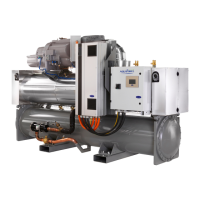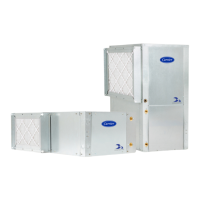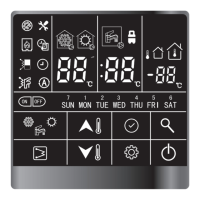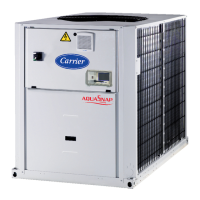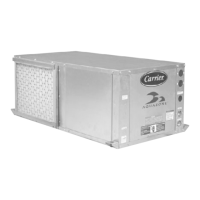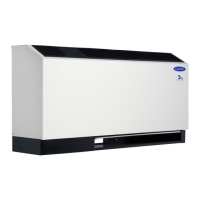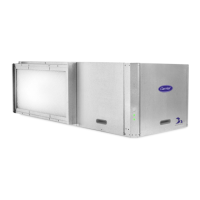10
2 - PRELIMINARY CHECKS
2.1 - Check equipment received
■ Inspect the unit for damage or missing parts. If damage is
detected, or if shipment is incomplete, immediately le a claim
with the shipping company.
■ Conrm that the unit received is the one ordered. Compare the
name plate data with the order.
■ The unit name plate must include the following information:
- Version number
- Model number
- CE marking
- Serial number
- Year of manufacture and test date
- Fluid being transported
- Refrigerant used and refrigerant class
- Refrigerant charge per circuit
- Containment uid to be used
- TS: Min./max. allowable temperature (high and low pressure
side)
(1)
- TS: Min./max. allowable temperature (high and low pressure
side)
- Pressure switch cut-out pressures
- Unit leak test pressure
- Voltage, frequency, number of phases
- Maximum current drawn
- Maximum power input
- Unit net weight
■ Conrm that all accessories ordered for on-site installation have
been delivered, and are complete and undamaged.
The unit must be checked periodically during its whole
operating life to ensure that no shocks (handling accessories,
tools etc.) have damaged it. If necessary, the damaged parts
must be repaired or replaced. See also chapter 12 “Standard
maintenance”.
(1) The TS maxi of the high pressure side shown in the unit name plate:
- corresponds to a superheated state of the refrigerant,
- affects only some components or parts of components of the high pressure side,
- as a consequence, may be higher than the TS of the other components of the
high pressure side.
If needed, refer to the PID provided for your unit, it shows this temperatures
repartition.
2.2 - Moving and sitting the unit
2.2.1 - Moving
See chapter 1.1 “Installation safety considerations”.
CAUTION: Only use slings at the designated lifting points
which are marked on the unit.
2.2.2 - Sitting the unit
Always refer to the chapter “Dimensions and clearances” to conrm
that there is adequate space for all connections and service operations.
For the centre of gravity coordinates, the position of the unit mounting
holes, and the weight distribution points, refer to the certified
dimensional drawing supplied with the unit.
Typical applications of these units are in refrigeration systems,
and they do not require earthquake resistance. Earthquake
resistance has not been veried.
Before siting the unit check that:
- the permitted loading at the site is adequate or that
appropriate strenghtening measures have been taken.
- the unit is installed level on an even surface (maximum
tolerance is 5 mm in both axes).
- there is adequate space above the unit for air ow and to
ensure access to the components.
- the number of support points is adequate and that they are
in the right places.
- the location is not subject to ooding.
CAUTION: Lift and set down the unit with great care. Tilting and
jarring can damage the unit and impair unit operation.
2.2.3 - Checks before system start-up
Before the start-up of the refrigeration system, the complete installation,
including the refrigeration system must be verified against the
installation drawings, dimensional drawings, system piping and
instrumentation diagrams and the wiring diagrams.
During the installation test national regulations must be followed.
If no national regulation exists, standards such EN-378 or ISO-
5149 can be used as a guide.
External visual installation checks:
- Ensure that the machine is charged with refrigerant. Verify
on the unit nameplate that the ‘uid being transported’ is
R1234ze(E) and is not nitrogen.
- Compare the complete installation with the refrigeration
system and power circuit diagrams.
- Check that all protection documents and equipment provided by the
manufacturer (dimensional drawings, PID, declarations etc.) to
comply with the regulations are present.
- Verify that the environmental safety and protection and devices
and arrangements provided by the manufacturer to comply with
the regulations are in place.
- Verify that all document for pressure containers, certicates, name
plates, les, instruction manuals provided by the manufacturer to
comply with the regulations are present.
- Verify the free passage of access and safety routes.
- Check that ventilation in the plant room is adequate.
- Check that refrigerant detectors are present.
- Verify the instructions and directives to prevent the deliberate
removal of refrigerant gases that are harmful to the
environment.
- Verify the installation of connections.
- Verify the supports and xing elements (materials, routing
and connection).
- Verify the quality of welds and other joints.
- Check the protection against mechanical damage.
- Check the protection against heat.
- Check the protection of moving parts.
- Verify the accessibility for maintenance or repair and to check
the piping.
- Verify the status of the valves.
- Verify the quality of the thermal insulation and of the vapour
barriers
- Check the condition of the insulation of the 400 V cables.
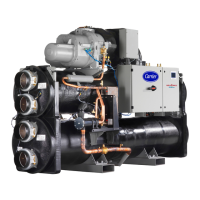
